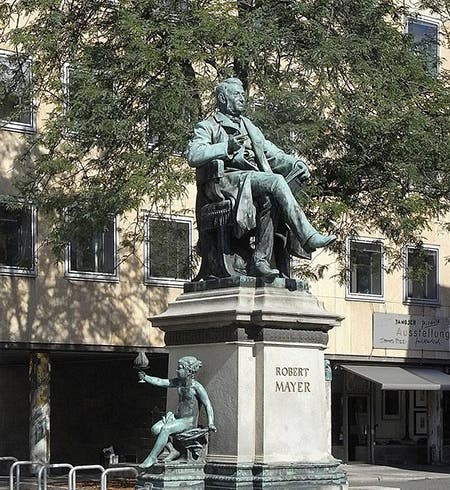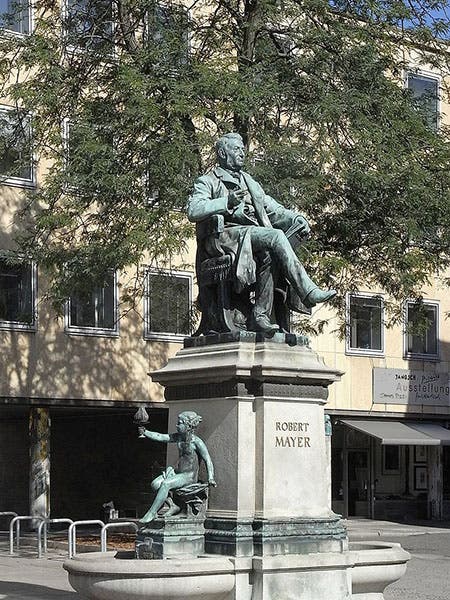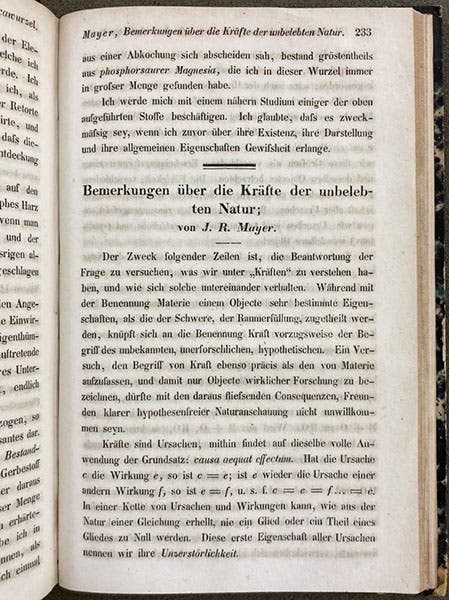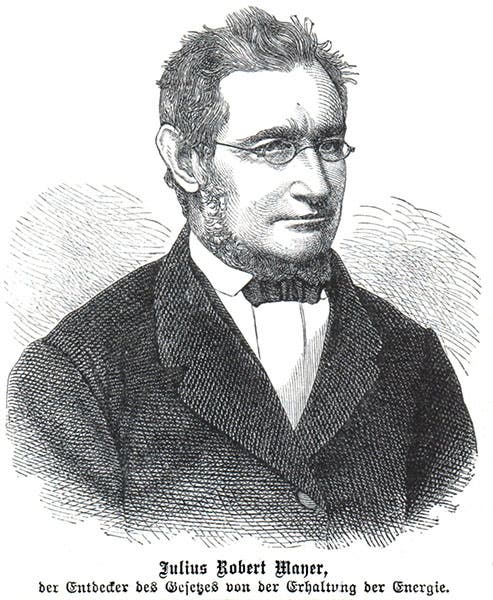Scientist of the Day - Julius Robert von Mayer
Julius Robert von Mayer, a German physician and would-be physicist, died Mar. 20, 1878, at the age of 63. The 1840s were an amazing decade in the history of thermodynamics, as a number of scientists, quite independently, discovered the principle of the conservation of energy. Actually, they discovered the concept of energy itself, and then that energy is a quantity that is conserved in all interactions. Most of those who stumbled on the idea of the conservation of energy, like James Joule, were mathematical or experimental physicists. Mayer, a medical man, was the exception.
Mayer (who went by the name of Robert) was born in Heilbronn in southwestern Germany, the son of a pharmacist. He attended medical school at the nearby University of Tübingen, and before he settled down to practice in Heilbronn, he decided to see the world, by way of signing on as ship’s doctor for a year-long Dutch voyage to the East Indies. While engaged in the bloodletting of several feverish sailors, he happened to notice that the blood in their veins was much redder than normal, almost as red as arterial blood, suggesting that the venous blood contained more oxygen than usual. Thinking upon the matter, he concluded if that the purpose of oxygen in the blood is to provide heat for the body through the oxidation of food, then people in the tropics will need less body heat, and will therefore use less oxygen. And this led Mayer to conclude that heat must be conserved in Nature, that the oxygen used by the body must be in proportion to the heat needed.
Upon his return to Heilbronn, Mayer pursued the matter, and he wrote up a paper in 1841 on the conservation of heat that he sent off to the Annalen der Physik, which the editor apparently thought so bizarre that he didn’t even bother to respond or return the manuscript. Mayer seems to have taken that as a sign that his first paper was lacking in precision, which it certainly was, and he composed a second, which he sent off to the Annalen der Chemie und Pharmacie, and this one was published, in 1842 (second image). Its title translates as: “Remarks on the forces of inanimate nature.” In it, Mayer, for the first time anywhere, calculated what would later be called the mechanical equivalent of heat; he concluded that a weight falling over the distance of 365 meters and impacting the ground would raise its temperature 1 degree Celsius. Heat and motion, he argued, were different manifestations of the same quantity, which we now call energy.
Although this paper was published, it was not favorably received in Germany, and indeed was savagely criticized on several occasions. Joule wrote his first paper on the mechanical value of heat the next year, in 1843, completely unaware of Mayer’s work. Mayer continued to practice as a physician, and wrote several more papers on energy topics, after he saw that Joule was being given credit for discovering the mechanical equivalent of heat, but to no effect. His life went downhill; he lost his two young daughters to illness in 1848; he tried to commit suicide in 1850 by throwing himself out a third-story window, which provided severe injuries but not death; and several years later, he became deranged and had to be confined to a mental institution. He gradually recovered and returned to medical practice, but he never went back to his work on energy conservation. His work might have lain unrecognized forever.
But it did not, thanks to the British penchant for scientific bickering. John Tyndall, a respectable physicist, was irritated by James Joule in general, and more specifically, by Joule’s claim to have discovered the conservation of energy (by that time it was known as the first law of thermodynamics), and he was miffed by Joule’s defenders as well, such as William Thomson (later Lord Kelvin). Tyndall had apparently heard of Mayer’s work, and in 1862, he wrote his German colleague, Rudolf Clausius, asking about Mayer; Clausius initially responded that Mayer’s work was unlikely to contain anything important, but he then took a closer look at the 1842 paper and realized that Mayer had really gotten right to the heart of the matter, and he told Tyndall that Mayer had written a brilliant paper on the conservation of energy, and had done so before Joule, and he sent a copy of the paper along. Tyndall then gave a lecture at the Royal Institution in London later in 1862 and championed Mayer as the discoverer of the first law of thermodynamics, to the great consternation of the community of British physicists. Tyndall said of Mayer: “Here was a man of genius working in silence, animated solely by a love of his subject, and arriving at the most important results some time in advance of those whose lives were entirely devoted to Natural Philosophy [i.e., Joule and Thomson].” Almost immediately, Mayer’s German paper of 1842 was translated into English and published later that same year in the influential Philosophical Magazine (more accurately, the London, Edinburgh, and Dublin Philosophical Magazine). We see here the first page of the translated article, which undramatically begins at the bottom of the page (fourth image). The editor, in a footnote that runs onto the next page, commented: “Considerable attention having of late been called to the author of this paper, as one of the earliest propounders of the doctrine of the Indestructibility of Force, and especially of the idea of the equivalence of Heat and Work, it will probably interest many readers of the Philosophical Magazine to have placed in their hands his earliest publication on the subject,”, and then refers the reader to Tyndall’s lecture, which had been published several months earlier in a previous issue of the same journal.
So Mayer’s reputation was restored, and while the English never warmed to his scooping of Joule, Germans rallied behind him. He was ennobled, allowing him to use the name “Robert von Mayer,” and by the time of his death in 1878, he was a national hero. And he is still a prominent historical figure in southern Germany. There is a beautiful bronze statue in his honor in the city square of his home town of Heilbronn (first image). And he is now in all the textbooks as the first of the many independent discoverers of the First Law of Thermodynamics.
William B. Ashworth, Jr., Consultant for the History of Science, Linda Hall Library and Associate Professor emeritus, Department of History, University of Missouri-Kansas City. Comments or corrections are welcome; please direct to ashworthw@umkc.edu.










